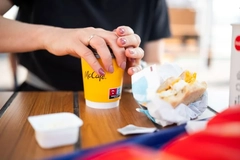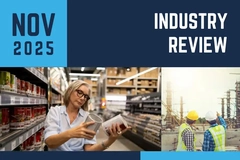For the food industry, the robust packaging is vital because they are lightweight, can be stacked to save space and hence transport cost. At the same time they protect the products from moisture, dirt and damage. But the cardboard from recycled paper can contain mineral oil residues. Coating solutions from BASF protect the food from these substances.
Products-filled shelves, as far as the eye can see: packages of cereal, rice, pasta and baking mixes stand side by side on the supermarket shelves. In the freezers pizzas, vegetables and fish fillets - well packed in colorful cartons lure your eyes. For the food industry, the robust packaging is vital because they are lightweight, can be stacked to save space and hence transport cost. At the same time they protect the products from moisture, dirt and damage. But the cardboard from recycled paper can contain mineral oil residues. Coating solutions from BASF protect the food from these substances.
Cardboard packaging for food products are often made from recycled waste paper such as newspapers. This paper contains, among other remains of newspaper inks. They consist of mineral oils, which are not approved for food contact. And here lies the problem: The mineral oils may not be completely removed in the recycling process and thus pass into the packaging. However, mineral oils contain hydrocarbon compounds that can go from the box to the food.
Experts speak of migration
And it does not even need a direct contact between the carton and the food: Some petroleum residues evaporate at room temperature. This gas mixture propagates in the packaging, and the substances may be absorbed by the food. "Investigations by the State Laboratory in Zurich have shown that after only two months, around 30 percent of all migratable substances are passed into the food," said Heiko Diehl. BASF's manager is responsible for the supervision of international branded goods manufacturers in Business Paper Chemicals. The mainly products of concern are products such as flour, rice or baking mixes because they can absorb the mineral components in larger quantities. "The pollutants themselves have entered into the food, they can not be removed by washing or cooking thus making them harmless," said Diehl.
The health risk that may emanate from the mineral oils in food packaging are not only an issue for the industry. The petroleum residues in food and their effects are also an issue with the competent supervisory authorities in Switzerland. In control studies, the scholars there have demonstrated high residues of these substances in human tissue. Dr. Konrad Grob from the State Laboratory in Zurich: "The consumption of cardboard boxes for packaging of food is so high that the use of recycled materials is unavoidable. Although there is as yet no legally binding limit values, only official recommendations. These values ??can not be adhered to during prolonged storage without barrier for most products," says Grob.
BASF has already developed a number of barrier solutions that can be applied to the inside of the boxes. These wafer-thin coatings made of polymers, ie macromolecules, which are composed of repeating smaller molecules. Already barrier coatings that are only ten to 15 microns thick exist- for comparison, a hair is up to 120 microns thick - that protect food for up to three years before the pollutants can enter them. This means that for products like pasta, the pasta can linger on average for 15 to 24 months in the packaging, protected. "The most important requirement of the barriers is that the so-called breakthrough time - ie the time until a barrier to leak and harmful substances can penetrate the food - is longer than the shelf life of the packaged product," says Diehl.
"With our barrier coatings, one can imagine a model like a close-knit network, that allows only certain molecules that pass," said Diehl. Only very small molecules such as water vapor are allowed to pass through. Larger molecules such as mineral oil residues can not pass. In addition, the polar nature of the BASF barriers hampers the migration of the molecules.
However, not only is the barrier been a challenge in the development of different coating solutions for large molecules. Dr. Carmen Cimpeanu from the material and system research of BASF explains: "At the same time, the coating must also be flexible so that when folding the cardboard boxes no breaking points occur and the protective layer is intact."
Once the coating finally fulfills its task, and the foods are eaten, the polymer film is to be simply removed again. Because when re-recycling the cardboard boxes it must not interfere, but simply must be able to be removed in the recycling process. Only then can the recycled paper easily handle becoming again the next cardboard packaging that will protect the next batch of pasta, cereal and Co..
"Sustainable packaging are in vogue"
Interview with Michael Avemarg, Innovation Manager Materials at the leading European folding carton manufacturer Van Genechten in Kempten. The company processes about 200,000 tons of cardboard annually.
What are the challenges for packaging manufacturers in the future?
Packaging must not only protect against mechanical stresses, but also from pollutants nowadays. Laboratories have increasingly accurate methods of analysis and may have undesirable substances always better determine. It will set new limits that we must consider as a packaging manufacturer. This also applies to mineral components in boxes. We expect strict limits and have already upgraded our production lines. In order to find optimal coating solutions for the manufacturing process, we have been working together with BASF, and test products for our plants. For the jointly developed WLC food safe coating, based on BASF's Ultramid, we have won in September the German Packaging Award 2013.
What is the packaging of the future?
The trend is especially towards sustainable packaging. The use of renewable raw materials and recycling processes will play a major role. The bio-based BASF coating ecovio variant, which we have already successfully tested on our systems, points in this direction. But also additional features such as higher heat resistance play an increasing role in packaging. And with the information that is applied to the package, more focus is put more and more on the new media: There is amplified links to home pages, and interactive contests that can use directly on his smartphone consumers. And augmented reality the packing can be provided with additional virtual information, animate or even show in 3-D.
Infobox:
Residues in the waste paper
Recycling cartons may contain petroleum residues up to 1,000 milligrams per kilogram. How strong in packaged foods are loaded by the transition of these substances, and to which substances that could potentially arise, is currently the subject of studies. The Cantonal Laboratory in Zurich has demonstrated already in 2010 large quantities of mineral oils in boxes. The experiments also showed that the substances accumulate in the body and can lead to inflammation in the liver and lymph nodes. In addition to recycling packaging and cartons of fresh wood fibers are affected when they are stored in paper boxes: The mineral constituents migrate through and reach the food.
Infobox:
Various barrier solutions
In Europe alone, there are over 1,000 manufacturers of carton packaging that have different production processes and coating methods, depending on system size. BASF offers these customers different coating solutions. Larger companies engage, for example, in the extrusion process. Here, a polymer melt is applied to the non-folded cardboard. For this method, the BASF Ultramid® material is suitable. It consists of the plastic polyamide. In contrast, smaller packaging manufacturers use printing techniques to apply coatings. You can with specially formulate aqueous acrylic dispersions as a protective layer on the carton. These dispersions can also be used by the paper industry for the coating. The product ecovio® PS 1606 is a polyester of polylactic acid mixture that has the advantage that it and the package are therefore biodegradable compostable. The packaging producers can muster it in the extrusion process on their cartons.
Source: BASF













